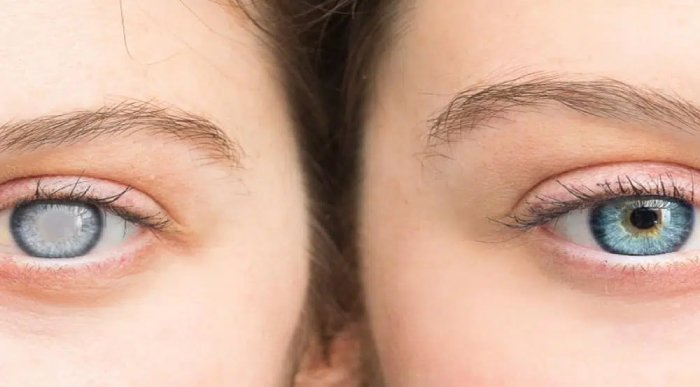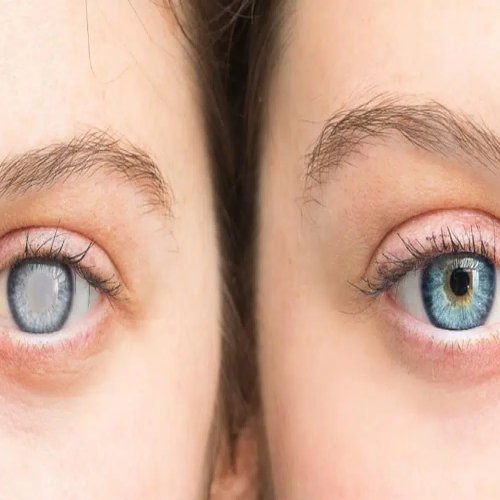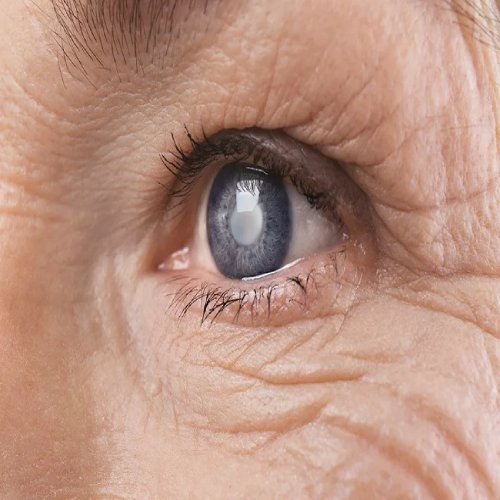About Cataracts
Cataracts occur when the natural lens of the eye becomes cloudy, affecting vision. The lens, which is normally clear, allows light to pass through to the retina, helping you see clearly. As cataracts develop, this cloudiness obstructs light, making it difficult to see. Cataracts can form in one or both eyes and are most commonly related to aging, though they can also be caused by injury, certain medical conditions, or long-term use of medications like steroids.
Symptoms of Cataracts
- Difficulty with depth perception
- Inconsistent clarity of vision throughout the day
- Visual distortions (wavy or warped images)
- Shadowy areas in the field of vision
- Eye strain or discomfort during visual tasks
- Sensitivity to bright sunlight or glare

Causes of Cataracts
- Types of Cataracts: Cataracts can be categorized into age-related, congenital, secondary (due to other conditions), and traumatic cataracts.
Development Process: Cataracts develop gradually, often starting as small opacities in the lens that worsen over time.
Impact on Daily Life: Cataracts can significantly affect daily activities, making tasks like reading, driving, and recognizing faces challenging.
Color Perception Changes: People with cataracts may notice a yellowing or browning of their vision, affecting color discrimination.
Diagnosis Tools: In addition to standard eye exams, tools like tonometry measure intraocular pressure, and optical coherence tomography (OCT) can assess lens clarity.
Lifestyle Modifications: Patients are often advised to make lifestyle changes, such as improving lighting in the home and using anti-glare lenses.

Our Cataracts Treatment Options
- Monitoring: Early-stage cataracts may just require regular eye exams to track changes in vision.
- Prescription glasses: New lenses can help manage vision changes caused by cataracts.
- Contact lenses: Specialized lenses may be recommended for better vision correction.
- Surgery: The most effective treatment for significant cataracts, involving removal of the cloudy lens.
- Phacoemulsification: A common surgical method that uses ultrasound to break up and remove the cataract.
- Extracapsular cataract extraction: Involves removing the cataract in one piece, often used for advanced cataracts.
- Intraocular lenses (IOLs): Artificial lenses implanted after cataract removal to restore vision.
When You Need
Treatment Cataract



Blurry or Cloudy Vision: As cataracts develop, your vision may become hazy or blurry, making it harder to see clearly, even with glasses or contact lenses.
Difficulty Seeing at Night: Cataracts often cause poor night vision, which can make driving or navigating in low-light conditions challenging and dangerous.
Sensitivity to Light and Glare: If you start experiencing discomfort from bright lights, such as sunlight or car headlights, or if halos appear around lights, it may indicate cataracts.
Fading or Yellowing of Colors: Colors may seem less vibrant, faded, or have a yellow tint as the cataract worsens.
Double Vision: Cataracts can cause double vision in one eye (monocular diplopia), which may not improve with corrective lenses.
Frequently Asked Questions
The most common cause of cataracts is aging, but other factors can contribute, including:
- Prolonged exposure to ultraviolet (UV) light
- Diabetes
- Smoking
Symptoms of cataracts develop slowly and can include:
- Blurry, cloudy, or dim vision
- Difficulty seeing at night or in low light
- Sensitivity to light and glare
Cataracts need treatment when they start to interfere with your daily activities, such as reading, driving, or recognizing faces. Early on, you may manage symptoms with stronger glasses or better lighting.
Several types of IOLs are available, including:
- Monofocal IOLs: Provide clear vision at one distance, usually set for distance vision, so you may still need glasses for near tasks like reading.
- Multifocal or bifocal IOLs: Provide clear vision at multiple distances, reducing the need for glasses.
24 / 7 HOURS SERVICE
